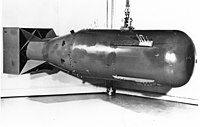
Photo from wikipedia
Background Ionizing radiation and chemical pollution can disrupt normal embryonic development and lead to congenital malformations and fetal death. We used official government statistical data for 2000–2017 to test the… Click to show full abstract
Background Ionizing radiation and chemical pollution can disrupt normal embryonic development and lead to congenital malformations and fetal death. We used official government statistical data for 2000–2017 to test the hypothesis that radioactive and chemical pollutants influenced the frequency of de novo congenital malformations in newborns of the Bryansk region of southwest Russia. Methods A variety of statistical approaches were used to assess congenital malformation frequencies including the Shapiro-Wilk test, White's homoscedasticity test, Wilcoxon T-test, Spearman's rank correlation test, and the inversely proportional regression. Results We found that the frequency of polydactyly, multiple congenital malformations, and the frequency of de novo congenital malformations in newborns were significantly higher (p = 0.001–0.054) in regions with elevated radioactive, chemical and combined contamination. Polydactyly, multiple congenital malformations, and the sum of all congenital malformations were 4.7–7.4 times, 2.5–6.8 times, and 3.5–4.6 times higher in contaminated regions in comparison with the control group. The combination of both radioactive and chemical pollutants led to significantly higher frequencies of multiple congenital malformations when compared to regions with only one pollutant (radiation alone: 2.2 times, p = 0.034; chemical pollutants alone: 1.9 times, p = 0.008) implying that the effects of these stressors were at minimum additive. Although there was a trend for decreasing frequencies of multiple congenital malformations during the 2000–2017 period in areas of combined pollution, the opposite was true for regions with radioactive or chemical pollutants alone. However, overall, our models suggest that the frequency of multiple congenital malformations in areas of combined pollution will significantly (p = 0.027) exceed the frequencies observed for regions containing radioactive or chemical pollutants alone by 39.6% and 45.7% respectively, by 2018–2023. Conclusion These findings suggest additive and potentially synergistic effects of radioactive and chemical pollutants on the frequencies of multiple congenital malformations in the Bryansk region of southwestern Russia.
Journal Title: Heliyon
Year Published: 2020
Link to full text (if available)
Share on Social Media: Sign Up to like & get
recommendations!